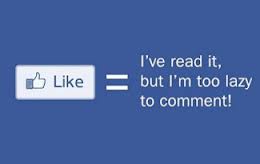Keith Hannon (@KeithHannon) is the associate director for social media at Cornell University.
If there’s one thing savvy, social media professionals love to talk about, it’s metrics. For those not in the business, this can be either coma-inducing dinner conversation or insomnia-curing nerdiness.
During the past year, I’ve heard many people dismiss Facebook likes as nothing more than a vanity metric, suggesting they do not serve as evidence of engagement. I’ve come full circle with regards to my opinion. When I first began dipping my toe into the social media waters, I was frequently excited when posts received dozens of likes and was obsessed with increasing the overall like count of the page I was managing. Then, as I developed social media maturity, I took up arms with the vanity metric caucus, turning my focus to posting content designed to trigger comments versus the “lazy” alternative of liking a post.
(Too lazy or too busy?)
Now, I have a new perspective on the like. As our team continues to explore prospect identification through social media, I now believe that a like is much more than just low-level engagement. Recently, we made a post on the Cornell Alumni Facebook page that received more than 500 likes. At first, I thought “that’s great, but what are they SAYING about it?” Then, after climbing down from my social media high horse, I realized that I had a list of 500 people who had just admitted their affection for a specific area of the university. Facebook no longer allows you to see a list of everyone who has liked your page, but it does allow you to see who liked a post (500 is a good number to start with). You can then check these names against your database and see if they are tracked prospects.
Sure, simply liking a post or page isn’t the same as volunteering to host an event in your backyard, but it shows interest nonetheless. It is opt-in interaction regardless of whether a person leaves a five-sentence comment or simply takes a second to click the like button. At times, it seems like we dive too deeply into defining engagement and what it means to have a bustling, active online community. When it comes to proving social media’s return on investment, it comes down to the individuals within your community who can help to advance your institution. Highly successful people don’t generally have the time to write long, thought-out comments, but almost everyone has the time to like something.
While interesting and authentic content is still important, can we really dismiss ANY metrics in an industry where we struggle to connect dollar signs to our day-to-day activities? We’re in the social media business and have a deep commitment to technology, trends and an overall geekiness that can lead to overthinking things. We need to remember we do social media ON BEHALF OF a department that’s very much in the people business. The next like on your page could be that of your next $100,000 donor who just provided your gift officer with a conversational piece on a silver platter.


Pingback: ROI, Digital Identity, Student Engagement and More: 2013 CASE Content to Guide Your 2014 | CASE Blog·
Thoughtful post, Keith, thanks.
In your opinion, besides Facebook, is there any other social media site that warrants attention and time spent on it? YouTube, Twitter, Instagram, Google+, Pinterest, etc?
Also, you mentioned in your post – “You can then check these names against your database and see if they are tracked prospects.”
How are you checking these names against your database? Manually?
Great post and totally agree with where you’re going. Now, my question is – what is the best way to interact with these people without creeping them out? One thought is to tag them in a response comment, but I’d love to hear what you think. Thanks!
The value of a like = Reach. Every time someone likes a facebook post, everyone in their audience sees that post. Your engaged fan, through liking becomes a brand ambassador for your post.
The value of a like = baby steps. It is human nature not to start interactions by getting up in the middle of a party and singing. Well, at least for most of us. If we think of a facebook page like an ongoing salon themed to your brand, a like is an affirmation, like nodding your head or laughing, that you are enjoying/connecting to what is going on. Forrester shows us that most users are not commenters and the vast majority are lurkers who do not “show themselves” through interaction. With that in mind, the like is a valuable way to indicate resonance.
Before I began reading, I had already determined I was going to disagree with you. That did not happen. Kudos.
Great article. I love hearing about integration of social metrics with prospect tracking; schools (including my own) can and should investigate more of that.
I’ve never bought the blanket dismissal of the “like.” If nothing else it’s validation that fans like what they’re seeing, and want to see more of it / more like it. I think we all know from experience that some posts, and even some pages/brands, don’t benefit from that validation�because people don’t like their content. And I think we can infer that if people do take the time to “like” posts, that they are also taking time to absorb our message, at least at a cursory level. That’s worth something.
Couldn’t agree more, Patrick! Thanks for reading/sharing!
Love this post, Keith. The value of a “Like” is whatever you determine it to be. It’s great to see someone looking past the raw numbers to determine what a “Like” actually means to your business.